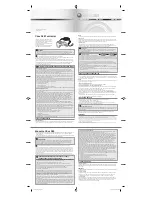
Chapter 12. Preparing to install or change a cluster solution
Note:
If you are going to upgrade an existing high-availability cluster solution and
are already familiar with the concepts of a cluster, go to “Updating the
ServeRAID BIOS, firmware, and software code for clustering” on page 141. If
you are setting up a high-availability cluster solution for the first time,
continue reading this section.
Before you begin installing and setting up a high-availability cluster solution,
familiarize yourself with the following terms and definitions, as well as some
considerations concerning the ServeRAID controller.
Terms and definitions
The following terms are used in this section. For a detailed explanation of these
terms, see the Server Cluster Glossary in the Windows Platform Software
Developers Kit.
Failover
is the process of relocating the cluster resources from a failed server to
the remaining server. The resource-monitor program responsible for the resource
detects the failure. If a resource failure occurs, the resource-monitor program
notifies the Cluster Service, which triggers the actions that are defined in the
failover policy for that resource. A failover can occur automatically, such as when an
application or a server fails, or it can occur manually, such as when a system
administrator moves all applications onto one server and then shuts down the other
server for scheduled maintenance. Failover generally includes three tasks:
v
Failure detection
v
Resource relocation
v
Application restart
Failback
is a special case of failover. It is the process of moving back some or all
groups of resources to the preferred owner after a failover has occurred. The
preferred owner
is the server in the cluster on which you prefer each group of
resources to run. If the preferred owner fails, its resources are transferred to the
other server. When the preferred owner is repaired and comes back online and
allow failback
is enabled in the Microsoft Cluster Administration program, the
resources are automatically transferred back to that server.
Resource Group
is a set of dependent resources that you can group together.
Some cluster resources cannot go online unless other cluster services are running.
These services are
resource dependencies
. When one resource is listed as a
dependency for another resource, the two resources must be placed in the same
group. If all resources are ultimately dependent on one resource (for example, one
physical disk resource), all resources must be in the same group. Therefore, all
resources in a cluster might need to be in the same group.
Furthermore, any cluster operation performed on a group is performed on all
resources that are in that group. For example, if a resource must be moved from
Server A to Server B, all resources that are in the same group as the resource will
be moved also.
© Copyright IBM Corp. 2002
107
Summary of Contents for ServeRAID
Page 1: ...IBM ServeRAID User s Reference Version 5 10 SC33 P263 60...
Page 10: ...x IBM ServeRAID User s Reference Version 5 10...
Page 16: ...xvi IBM ServeRAID User s Reference Version 5 10...
Page 17: ...Part 1 Installation and configuration Copyright IBM Corp 2002 1...
Page 18: ...2 IBM ServeRAID User s Reference Version 5 10...
Page 26: ...10 IBM ServeRAID User s Reference Version 5 10...
Page 36: ...20 IBM ServeRAID User s Reference Version 5 10...
Page 50: ...34 IBM ServeRAID User s Reference Version 5 10...
Page 63: ...Figure 19 Hints and tips feature Chapter 4 Configuring ServeRAID controllers 47...
Page 64: ...48 IBM ServeRAID User s Reference Version 5 10...
Page 66: ...50 IBM ServeRAID User s Reference Version 5 10...
Page 80: ...64 IBM ServeRAID User s Reference Version 5 10...
Page 81: ...Part 2 Utility programs Copyright IBM Corp 2002 65...
Page 82: ...66 IBM ServeRAID User s Reference Version 5 10...
Page 86: ...70 IBM ServeRAID User s Reference Version 5 10...
Page 116: ...100 IBM ServeRAID User s Reference Version 5 10...
Page 117: ...Part 3 Installing the IBM ServeRAID Cluster Solution Copyright IBM Corp 2002 101...
Page 118: ...102 IBM ServeRAID User s Reference Version 5 10...
Page 122: ...106 IBM ServeRAID User s Reference Version 5 10...
Page 126: ...110 IBM ServeRAID User s Reference Version 5 10...
Page 134: ...118 IBM ServeRAID User s Reference Version 5 10...
Page 150: ...134 IBM ServeRAID User s Reference Version 5 10...
Page 155: ...Part 4 Maintenance and troubleshooting Copyright IBM Corp 2002 139...
Page 156: ...140 IBM ServeRAID User s Reference Version 5 10...
Page 158: ...142 IBM ServeRAID User s Reference Version 5 10...
Page 190: ...174 IBM ServeRAID User s Reference Version 5 10...
Page 193: ...Part 5 Appendixes Copyright IBM Corp 2002 177...
Page 194: ...178 IBM ServeRAID User s Reference Version 5 10...
Page 198: ...182 IBM ServeRAID User s Reference Version 5 10...
Page 210: ...194 IBM ServeRAID User s Reference Version 5 10...
Page 220: ...204 IBM ServeRAID User s Reference Version 5 10...
Page 225: ......
Page 226: ...Part Number 33P2636 Printed in U S A SC33 P263 60 1P P N 33P2636...
















































